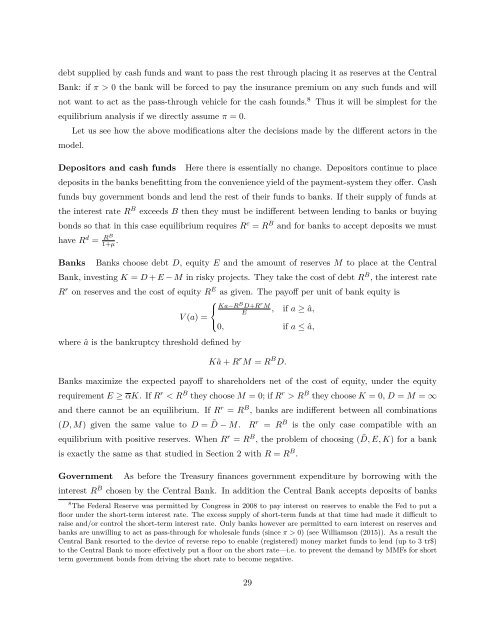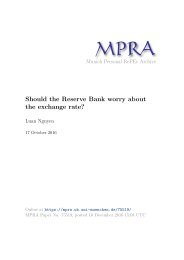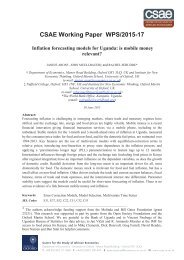debtequity
n?u=RePEc:red:sed016:1511&r=cba
n?u=RePEc:red:sed016:1511&r=cba
Create successful ePaper yourself
Turn your PDF publications into a flip-book with our unique Google optimized e-Paper software.
debt supplied by cash funds and want to pass the rest through placing it as reserves at the Central<br />
Bank: if π > 0 the bank will be forced to pay the insurance premium on any such funds and will<br />
not want to act as the pass-through vehicle for the cash founds. 8<br />
equilibrium analysis if we directly assume π = 0.<br />
model.<br />
Thus it will be simplest for the<br />
Let us see how the above modifications alter the decisions made by the different actors in the<br />
Depositors and cash funds<br />
Here there is essentially no change. Depositors continue to place<br />
deposits in the banks benefitting from the convenience yield of the payment-system they offer. Cash<br />
funds buy government bonds and lend the rest of their funds to banks. If their supply of funds at<br />
the interest rate R B exceeds B then they must be indifferent between lending to banks or buying<br />
bonds so that in this case equilibrium requires R c = R B and for banks to accept deposits we must<br />
have R d = RB<br />
1+µ .<br />
Banks<br />
Banks choose debt D, equity E and the amount of reserves M to place at the Central<br />
Bank, investing K = D + E − M in risky projects. They take the cost of debt R B , the interest rate<br />
R r on reserves and the cost of equity R E as given. The payoff per unit of bank equity is<br />
⎧<br />
⎨ Ka−R B D+R r M<br />
E<br />
, if a ≥ â,<br />
V (a) =<br />
⎩<br />
0, if a ≤ â,<br />
where â is the bankruptcy threshold defined by<br />
Kâ + R r M = R B D.<br />
Banks maximize the expected payoff to shareholders net of the cost of equity, under the equity<br />
requirement E ≥ αK. If R r < R B they choose M = 0; if R r > R B they choose K = 0, D = M = ∞<br />
and there cannot be an equilibrium. If R r = R B , banks are indifferent between all combinations<br />
(D, M) given the same value to D = D˜<br />
− M. R r = R B is the only case compatible with an<br />
equilibrium with positive reserves. When R r = R B , the problem of choosing ( ˜D, E, K) for a bank<br />
is exactly the same as that studied in Section 2 with R = R B .<br />
Government<br />
As before the Treasury finances government expenditure by borrowing with the<br />
interest R B chosen by the Central Bank. In addition the Central Bank accepts deposits of banks<br />
8 The Federal Reserve was permitted by Congress in 2008 to pay interest on reserves to enable the Fed to put a<br />
floor under the short-term interest rate. The excess supply of short-term funds at that time had made it difficult to<br />
raise and/or control the short-term interest rate. Only banks however are permitted to earn interest on reserves and<br />
banks are unwilling to act as pass-through for wholesale funds (since π > 0) (see Williamson (2015)). As a result the<br />
Central Bank resorted to the device of reverse repo to enable (registered) money market funds to lend (up to 3 tr$)<br />
to the Central Bank to more effectively put a floor on the short rate—i.e. to prevent the demand by MMFs for short<br />
term government bonds from driving the short rate to become negative.<br />
29





